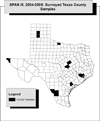Changes in the regional prevalence of child obesity in 4th, 8th, and 11th grade students in Texas from 2000-2002 to 2004-2005
- PMID: 19798066
- PMCID: PMC5150267
- DOI: 10.1038/oby.2009.305
Changes in the regional prevalence of child obesity in 4th, 8th, and 11th grade students in Texas from 2000-2002 to 2004-2005
Abstract
Although national and state estimates of child obesity are available, data at these levels are insufficient to monitor effects of local obesity prevention initiatives. The purpose of this study was to examine regional changes in the prevalence of obesity due to statewide policies and programs among children in grades 4, 8, and 11 in Texas Health Services Regions (HSRs) between 2000-2002 and 2004-2005, and nine selected counties in 2004-2005. A cross-sectional, probability-based sample of 23,190 Texas students in grades 4, 8, and 11 were weighed and measured to obtain BMI. Obesity was >95th percentile for BMI by age/sex using Centers for Disease Control and Prevention growth charts. Child obesity prevalence significantly decreased between 2000-2002 and 2004-2005 for 4th grade students in the El Paso HSR (-7.0%, P = 0.005). A leveling off in the prevalence of obesity was noted for all other regions for grades 4, 8, and 11. County-level data supported the statistically significant decreases noted in the El Paso region. The reduction of child obesity levels observed in the El Paso area is one of the few examples of effective programs and policies based on a population-wide survey: in this region, a local foundation funded extensive regional implementation of community programs for obesity prevention, including an evidence-based elementary school-based health promotion program, adult nutrition and physical activity programs, and a radio and television advertising campaign. Results emphasize the need for sustained school, community, and policy efforts, and that these efforts can result in decreases in child obesity at the population level.
Figures





References
-
- Ogden CL, Carroll MD, Flegal KM. High body mass index for age among US children and adolescents, 2003–2006. JAMA. 2008;299(20):2401–2405. - PubMed
-
- Swinburn B. Obesity prevention in children and adolescents. Child Adol Psychatric Clin North America. 2009;18(1):209–223. - PubMed
-
- Kropski JA, Keckley PH, Jensen GL. School-based obesity prevention programs: an evidence-based review. Obesity. 2008;16(5):1009–1018. - PubMed
-
- American Dietetic Association. Position of the American Dietetic Association: Individual-, family-, school-, and community-based interventions for pediatric overweight. J Amer Diet Assoc. 2006;106:925–945. - PubMed
-
- Economos CD, Hyatt RR, Goldberg JP, Must A, Naumova EN, Collins JJ, et al. A community intervention reduces BMI z-score in children: Shape up Somerville first year results. Obesity. 2007 May;15(5):1325–1336. - PubMed
Publication types
MeSH terms
Grants and funding
LinkOut - more resources
Full Text Sources
Medical

